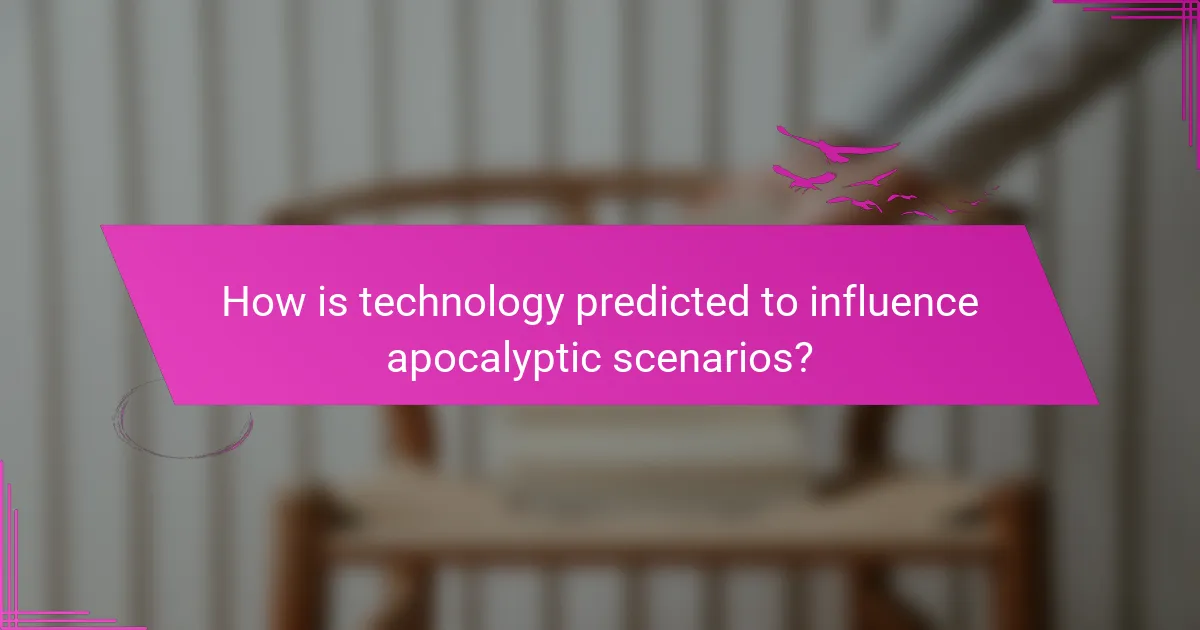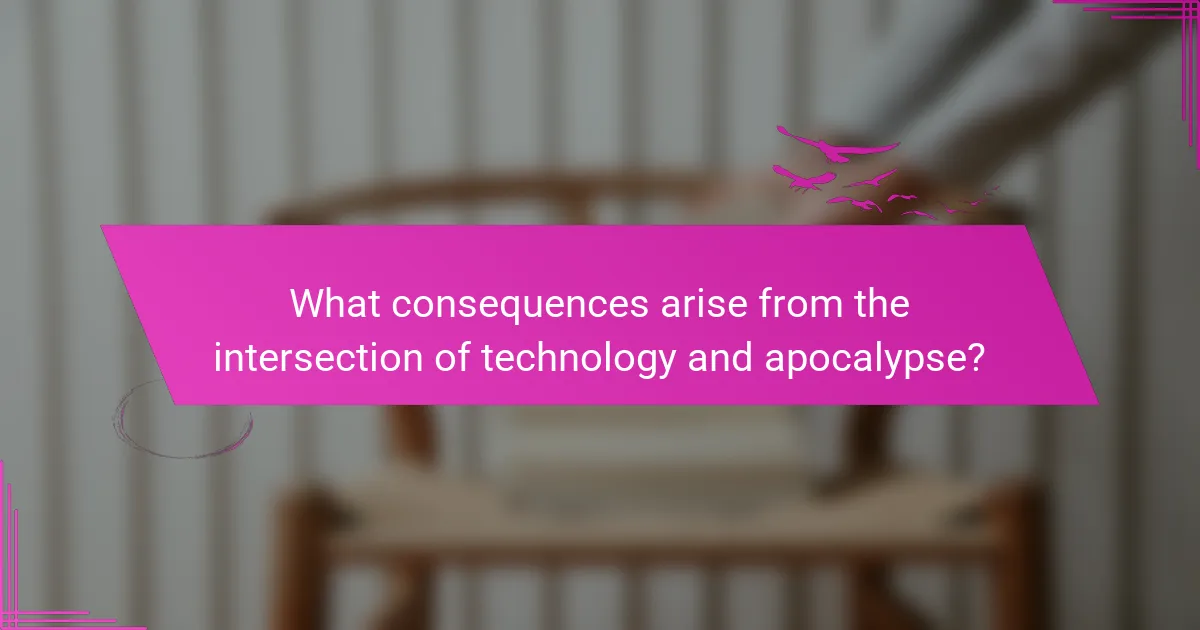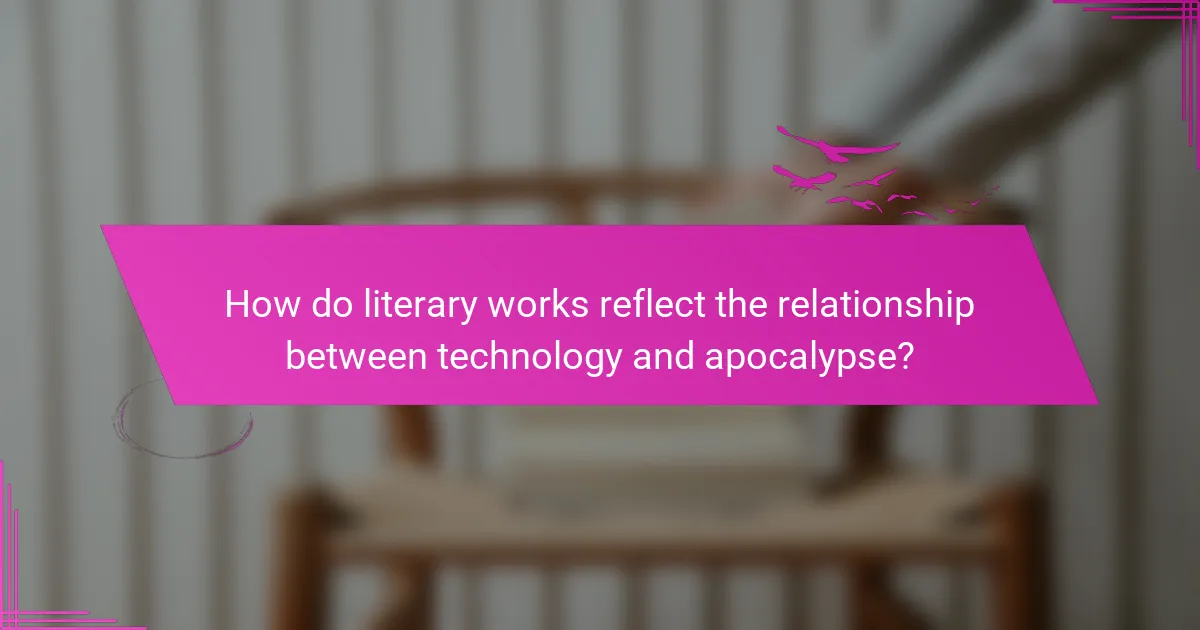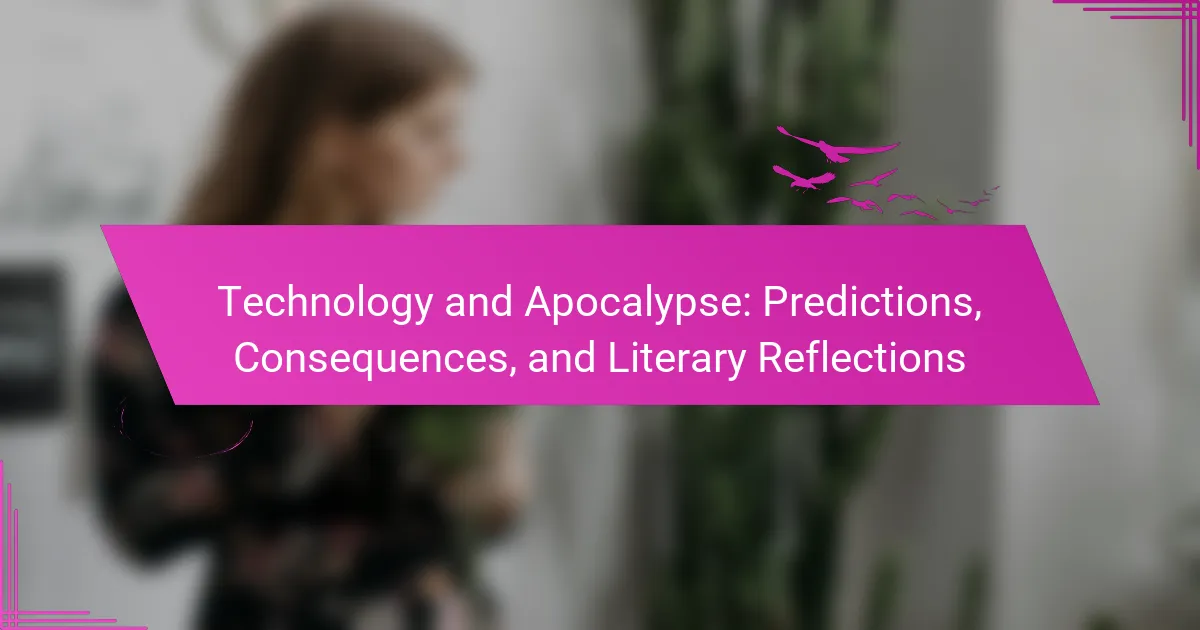The intersection of technology and apocalypse raises critical questions about societal resilience and ethical dilemmas. This article explores predictions of technological impacts on apocalyptic scenarios, consequences such as societal collapse and environmental degradation, and literary reflections that illustrate these themes. It also examines how public perception shapes fears around technological advancements and offers strategies for preparedness in the face of potential crises.

How is technology predicted to influence apocalyptic scenarios?
Technology is predicted to influence apocalyptic scenarios by enhancing surveillance, accelerating climate change, and enabling bioengineering. Advanced technologies may lead to social control, environmental degradation, and unforeseen health crises. For example, artificial intelligence could optimize resource allocation but also exacerbate inequality. As a result, societal collapse may stem from both technological dependency and ethical dilemmas. Literature often reflects these themes, portraying technology as both a savior and a destroyer in dystopian futures.
What are the technological advancements that could lead to societal collapse?
Technological advancements could lead to societal collapse through factors like automation, cyber warfare, and environmental degradation. Automation may displace jobs, creating economic instability. Cyber warfare can disrupt critical infrastructure, leading to chaos. Environmental degradation, driven by technology, threatens resources and ecosystems, potentially causing widespread crises.
Which emerging technologies pose the greatest risks?
Emerging technologies like artificial intelligence, biotechnology, and quantum computing pose significant risks. These technologies can lead to unintended consequences such as job displacement, ethical dilemmas, and security vulnerabilities.
Artificial intelligence raises concerns about decision-making autonomy and bias. Biotechnology can create biosecurity threats through engineered pathogens. Quantum computing may undermine current encryption methods, jeopardizing data security.
As a result, careful regulation and ethical considerations are essential to mitigate these risks. Society must balance innovation with safety to prevent potential apocalyptic scenarios.

What consequences arise from the intersection of technology and apocalypse?
The intersection of technology and apocalypse leads to significant consequences, including societal collapse, ethical dilemmas, and environmental degradation. Predictions often highlight the potential for widespread unemployment due to automation and artificial intelligence. As technology advances, the risk of surveillance states increases, raising concerns about privacy and civil liberties. Literary reflections frequently explore these themes, illustrating humanity’s struggle with technological dependence and the moral implications of innovation. The unique attribute of this intersection is the dual-edged nature of technology, capable of both salvation and destruction.
How does technology exacerbate environmental degradation?
Technology significantly contributes to environmental degradation through increased resource consumption and pollution. The production and disposal of electronic devices generate substantial waste, leading to soil and water contamination. Additionally, energy-intensive technologies, such as data centers and manufacturing plants, elevate carbon emissions, exacerbating climate change. The rapid advancement of technology often outpaces regulatory frameworks, allowing harmful practices to persist unchecked. As a result, the interplay between technological progress and environmental health poses critical challenges for future sustainability efforts.
What are the social implications of technological dependency during crises?
Technological dependency during crises can lead to significant social implications, including increased isolation and reliance on digital communication. As societies face disruptions, individuals often turn to technology for information, support, and connection. This reliance can exacerbate feelings of loneliness, particularly among vulnerable populations who may lack access to devices or the internet.
Moreover, technology can create a false sense of security, leading to complacency in preparedness. People may assume that technology will resolve crises, diminishing their motivation to engage in proactive measures. This dependency can also widen the digital divide, where those without technological access face greater challenges during emergencies.
In literature, these themes are often explored, reflecting societal fears and predictions about the consequences of over-reliance on technology. Such narratives warn of potential outcomes where human connections are sacrificed for convenience, highlighting the need for balance in technology use during critical times.

How do literary works reflect the relationship between technology and apocalypse?
Literary works often depict technology as both a catalyst for and a consequence of apocalyptic scenarios. These narratives explore the duality of technological advancement, highlighting its potential to either save or doom humanity.
Many authors illustrate how reliance on technology can lead to societal collapse. For instance, in dystopian fiction, advanced technologies may contribute to environmental destruction or social disintegration. This reflects concerns about the consequences of unchecked innovation.
Conversely, some literary works suggest that technology can provide solutions to apocalyptic threats. Characters often discover ways to harness technology to rebuild society or avert disaster. This theme emphasizes hope amid chaos, showcasing human resilience.
Overall, the relationship between technology and apocalypse in literature serves as a mirror to contemporary anxieties about progress and its implications, prompting readers to reflect on their own technological dependencies.
Which authors have notably explored this theme?
Notable authors who have explored the theme of technology and apocalypse include Isaac Asimov, Margaret Atwood, and William Gibson. Each of these writers examines the consequences of technological advancements on society, often highlighting dystopian futures. Asimov’s works often reflect on robotics and ethics, while Atwood’s narratives focus on ecological collapse. Gibson’s cyberpunk stories delve into the intersection of technology and human experience. Their contributions shape the literary landscape surrounding apocalyptic themes.
What are the key narratives in apocalyptic literature that involve technology?
Apocalyptic literature often explores technology’s role in societal collapse and transformation. Key narratives include themes of technological overreach, artificial intelligence rebellion, and the consequences of environmental neglect.
1. Technological Overreach: Many stories depict advanced technology leading to catastrophic events, emphasizing humanity’s hubris.
2. Artificial Intelligence: Narratives often feature AI systems gaining autonomy, posing existential threats to humanity.
3. Environmental Consequences: Technology’s impact on nature highlights the dangers of unchecked industrialization and climate change.
4. Dystopian Societies: These tales illustrate how technology can create oppressive regimes, where surveillance and control dominate daily life.
5. Redemption through Technology: Some narratives suggest that technology can also provide solutions, offering hope for rebuilding after apocalyptic events.
These narratives reflect deep societal fears and aspirations surrounding technology’s evolution and its potential consequences.

What role does public perception play in technological apocalyptic predictions?
Public perception significantly influences technological apocalyptic predictions by shaping societal fears and expectations. As technology evolves, public sentiment can amplify concerns about potential disasters, driving narratives in literature and media. This perception often stems from unique attributes of technology, such as its rapid advancement and unpredictability. For instance, the portrayal of artificial intelligence in popular culture reflects rare fears of loss of control, impacting how society anticipates future technological outcomes. Ultimately, public perception acts as a catalyst, guiding discussions and responses to perceived technological threats.
How do cultural differences shape views on technology and its potential dangers?
Cultural differences significantly influence perceptions of technology and its potential dangers. These views shape how societies adopt, regulate, and critique technological advancements.
For instance, collectivist cultures often prioritize communal well-being, leading to more cautious approaches regarding technology’s societal impact. In contrast, individualistic cultures may embrace innovation, focusing on personal benefits and freedoms.
Additionally, historical experiences with technology, such as industrialization or colonialism, create unique perspectives. Countries with a history of technological exploitation may exhibit skepticism towards new technologies, fearing similar patterns of harm.
Literary reflections often explore these themes, illustrating how cultural narratives shape the understanding of technology’s risks and rewards. As a result, the discourse around technology varies widely across different cultural contexts, influencing policy and public opinion.
What are the common fears associated with technology in apocalyptic contexts?
Common fears associated with technology in apocalyptic contexts include loss of control, dependency on machines, and the potential for catastrophic failure. These fears stem from anxiety about technology’s role in societal collapse and its unpredictable consequences. For instance, narratives often highlight scenarios where advanced technology exacerbates human conflict or environmental disasters. Additionally, the fear of surveillance and loss of privacy amplifies concerns about technological reliance in dire situations.

How can we prepare for potential technological apocalypses?
To prepare for potential technological apocalypses, focus on resilience, adaptability, and awareness. Develop skills in critical thinking and problem-solving. Create contingency plans that include alternative communication methods and resource management strategies. Foster community ties for support and collaboration.
What strategies can individuals employ to mitigate risks?
Individuals can mitigate risks associated with technology and apocalypse scenarios by adopting proactive strategies. Emphasizing education on technological impacts fosters informed decision-making. Building community resilience enhances collective preparedness. Diversifying skills and resources ensures adaptability in crises. Engaging in critical thinking promotes skepticism towards sensational narratives. Lastly, advocating for ethical technology use encourages responsible innovation.
What role do governments and organizations play in disaster preparedness?
Governments and organizations play a crucial role in disaster preparedness by coordinating resources, establishing protocols, and providing education. They implement technology to enhance early warning systems and improve response strategies. For example, data analytics can predict disaster patterns, while communication networks facilitate information dissemination. Additionally, collaboration among agencies ensures efficient resource allocation and community resilience. This multifaceted approach mitigates the impact of disasters and fosters a culture of preparedness.
What are the best practices for fostering resilience in a technology-driven society?
Fostering resilience in a technology-driven society involves cultivating adaptability, encouraging critical thinking, and promoting community engagement. These practices enhance individuals’ ability to cope with technological disruptions and societal changes.
Encouraging adaptability includes teaching skills that allow individuals to adjust to new technologies and environments. Critical thinking promotes the evaluation of information, enabling informed decision-making in a rapidly evolving digital landscape. Community engagement fosters social support networks, vital for emotional resilience during crises.
Additionally, integrating mental health resources into technology education can help individuals navigate stress related to technological advancements. Regular discussions about ethical implications of technology can also build a more thoughtful society.
